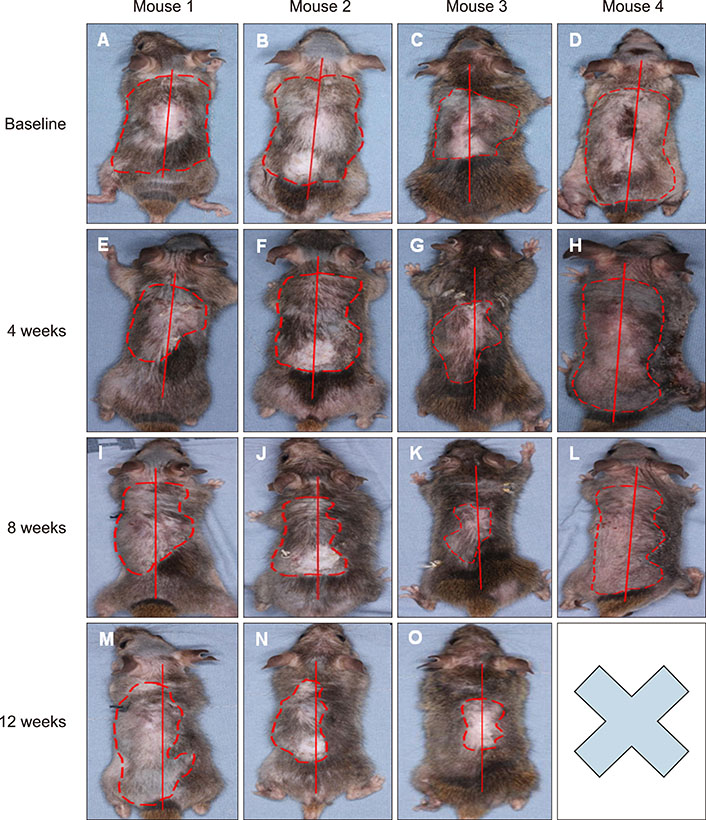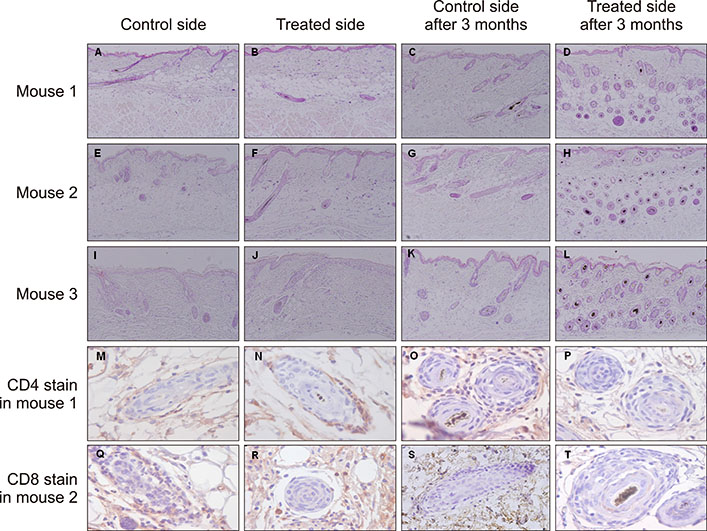Ann Dermatol.
2019 Aug;31(4):463-466. 10.5021/ad.2019.31.4.463.
Therapeutic Effect of 308-nm Excimer Laser on Alopecia Areata in an Animal Model
- Affiliations
-
- 1Department of Dermatology, Inha University Hospital, Inha University School of Medicine, Incheon, Korea. garden@inha.ac.kr
- KMID: 2451489
- DOI: http://doi.org/10.5021/ad.2019.31.4.463
Abstract
- No abstract available.
Figure
Reference
-
1. Alkhalifah A, Alsantali A, Wang E, McElwee KJ, Shapiro J. Alopecia areata update: part I. Clinical picture, histopathology, and pathogenesis. J Am Acad Dermatol. 2010; 62:177–188.2. Pratt CH, King LE Jr, Messenger AG, Christiano AM, Sundberg JP. Alopecia areata. Nat Rev Dis Primers. 2017; 3:17011.
Article3. Zöller M, McElwee KJ, Engel P, Hoffmann R. Transient CD44 variant isoform expression and reduction in CD4(+)/CD25(+) regulatory T cells in C3H/HeJ mice with alopecia areata. J Invest Dermatol. 2002; 118:983–992.
Article4. Kaufman G, d'Ovidio R, Kaldawy A, Assy B, Ullmann Y, Etzioni A, et al. An unexpected twist in alopecia areata pathogenesis: are NK cells protective and CD49b+ T cells pathogenic? Exp Dermatol. 2010; 19:e347–e349.
Article5. Novák Z, Bónis B, Baltás E, Ocsovszki I, Ignácz F, Dobozy A, et al. Xenon chloride ultraviolet B laser is more effective in treating psoriasis and in inducing T cell apoptosis than narrow-band ultraviolet B. J Photochem Photobiol B. 2002; 67:32–38.
Article6. Al-Mutairi N. 308-nm excimer laser for the treatment of alopecia areata. Dermatol Surg. 2007; 33:1483–1487.
Article7. Byun JW, Moon JH, Bang CY, Shin J, Choi GS. Effectiveness of 308-nm excimer laser therapy in treating alopecia areata, determined by examining the treated sides of selected alopecic patches. Dermatology. 2015; 231:70–76.
Article8. Cetin ED, Savk E, Uslu M, Eskin M, Karul A. Investigation of the inflammatory mechanisms in alopecia areata. Am J Dermatopathol. 2009; 31:53–60.
Article9. McElwee KJ, Rushton DH, Trachy R, Oliver RF. Topical FK506: a potent immunotherapy for alopecia areata? Studies using the Dundee experimental bald rat model. Br J Dermatol. 1997; 137:491–497.
Article10. McElwee KJ, Boggess D, King LE Jr, Sundberg JP. Experimental induction of alopecia areata-like hair loss in C3H/HeJ mice using full-thickness skin grafts. J Invest Dermatol. 1998; 111:797–803.
Article
- Full Text Links
- Actions
-
Cited
- CITED
-
- Close
- Share
- Similar articles
-
- Therapeutic Effects of 308 nm Excimer Laser in the Treatment of Vitiligo Patients: A Single Center Study in Korea
- Treatment of Laser Therapy-Induced Punctate Leukoderma Using a 308-nm Excimer Laser
- An Excimer Laser-Induced Eruptive Sebaceous Hyperplasia
- A Case of Congenitally Developed Alopecia Areata
- Short-term Effects of 308-nm Xenon-chloride Excimer Laser and Narrow-band Ultraviolet B in the Treatment of Vitiligo: A Comparative Study



